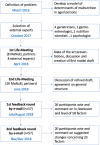Development of a Model on Determinants of Malnutrition in Aged Persons: A MaNuEL Project
- PMID: 31259204
- PMCID: PMC6589946
- DOI: 10.1177/2333721419858438
Development of a Model on Determinants of Malnutrition in Aged Persons: A MaNuEL Project
Abstract
In older persons, the origin of malnutrition is often multifactorial with a multitude of factors involved. Presently, a common understanding about potential causes and their mode of action is lacking, and a consensus on the theoretical framework on the etiology of malnutrition does not exist. Within the European Knowledge Hub "Malnutrition in the Elderly (MaNuEL)," a model of "Determinants of Malnutrition in Aged Persons" (DoMAP) was developed in a multistage consensus process with live meetings and written feedback (modified Delphi process) by a multiprofessional group of 33 experts in geriatric nutrition. DoMAP consists of three triangle-shaped levels with malnutrition in the center, surrounded by the three principal conditions through which malnutrition develops in the innermost level: low intake, high requirements, and impaired nutrient bioavailability. The middle level consists of factors directly causing one of these conditions, and the outermost level contains factors indirectly causing one of the three conditions through the direct factors. The DoMAP model may contribute to a common understanding about the multitude of factors involved in the etiology of malnutrition, and about potential causative mechanisms. It may serve as basis for future research and may also be helpful in clinical routine to identify persons at increased risk of malnutrition.
Keywords: determinants; etiology; malnutrition; model; older persons.
Conflict of interest statement
Declaration of Conflicting Interests: The authors declared no potential conflicts of interest with respect to the research, authorship, and/or publication of this article.
Figures


Similar articles
-
Relevant outcomes for nutrition interventions to treat and prevent malnutrition in older people: a collaborative senator-ontop and manuel delphi study.Eur Geriatr Med. 2018 Apr;9(2):243-248. doi: 10.1007/s41999-018-0024-8. Epub 2018 Jan 19. Eur Geriatr Med. 2018. PMID: 34654254
-
Joint action malnutrition in the elderly (MaNuEL) knowledge hub: summary of project findings.Eur Geriatr Med. 2020 Feb;11(1):169-177. doi: 10.1007/s41999-019-00264-3. Epub 2019 Nov 20. Eur Geriatr Med. 2020. PMID: 32297234
-
Prevalence of malnutrition using harmonized definitions in older adults from different settings - A MaNuEL study.Clin Nutr. 2019 Oct;38(5):2389-2398. doi: 10.1016/j.clnu.2018.10.020. Epub 2018 Nov 3. Clin Nutr. 2019. PMID: 30448194
-
Malnutrition in older adults: screening and determinants.Proc Nutr Soc. 2019 Aug;78(3):372-379. doi: 10.1017/S0029665118002628. Epub 2018 Dec 3. Proc Nutr Soc. 2019. PMID: 30501651 Review.
-
Assessment and treatment of malnutrition in Dutch geriatric practice: consensus through a modified Delphi study.Age Ageing. 2012 May;41(3):399-404. doi: 10.1093/ageing/afs005. Epub 2012 Feb 13. Age Ageing. 2012. PMID: 22334385 Review.
Cited by
-
Management of Malnutrition in Older Patients-Current Approaches, Evidence and Open Questions.J Clin Med. 2019 Jul 4;8(7):974. doi: 10.3390/jcm8070974. J Clin Med. 2019. PMID: 31277488 Free PMC article. Review.
-
Optimal Assessment of Nutritional Status in Older Subjects with the Chronic Obstructive Pulmonary Disease-A Comparison of Three Screening Tools Used in the GLIM Diagnostic Algorithm.Int J Environ Res Public Health. 2022 Jan 18;19(3):1025. doi: 10.3390/ijerph19031025. Int J Environ Res Public Health. 2022. PMID: 35162048 Free PMC article.
-
Effect of prehabilitation-related DIETary protein intake on Quality of Recovery after elective cardiac surgery (DIETQoR) study: protocol of a randomised controlled trial.BMJ Open. 2023 Jul 20;13(7):e069528. doi: 10.1136/bmjopen-2022-069528. BMJ Open. 2023. PMID: 37474186 Free PMC article.
-
Malnutrition and its associated factors among community-dwelling older men living alone.Nutr Res Pract. 2024 Jun;18(3):400-411. doi: 10.4162/nrp.2024.18.3.400. Epub 2024 May 23. Nutr Res Pract. 2024. PMID: 38854473 Free PMC article.
-
Theory-driven development of an educative nutritional intervention (ENI) supporting older hospital patients to eat sufficiently, assisted by an eHealth solution: an intervention mapping approach.BMC Health Serv Res. 2022 Nov 28;22(1):1435. doi: 10.1186/s12913-022-08679-8. BMC Health Serv Res. 2022. PMID: 36443804 Free PMC article.
References
-
- Amarya S., Singh K., Sabharwal M. (2015). Changes during aging and their association with malnutrition. Journal of Clinical Gerontology and Geriatrics, 6, 78-84. doi:10.1016/j.jcgg.2015.05.003 - DOI
-
- Diamond I. R., Grant R. C., Feldman B. M., Pencharz P. B., Ling S. C., Moore A. M., Wales P. W. (2014). Defining consensus: A systematic review recommends methodologic criteria for reporting of Delphi studies. Journal of Clinical Epidemiology, 67, 401-409. doi:10.1016/j.jclinepi.2013.12.002 - DOI - PubMed
LinkOut - more resources
Full Text Sources

